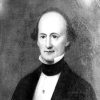calsfoundation@cals.org
Pope-Noland Duel
The Pope-Noland Duel took place in Arkansas Territory in 1831 between William Fontaine Pope and Charles Fenton Mercer (Fent) Noland. Little is known about Pope other than that he was the nephew and secretary of territorial governor John Pope, who was a member of the Democratic Party during his tenure in Arkansas. Fent Noland originally hailed from Virginia and was the son of politician and plantation owner William Noland, who drafted Virginia’s anti-dueling law. As a young lawyer, Fent Noland was mentored by James Woodson Bates, who was the first Arkansas territorial representative to the U.S. Congress, and went on to become a well-known writer who regularly published in the New York–based Spirit of the Times.
The political scene in the first half of the nineteenth century was split between the Democrats and the Whigs. For the Democrats, the most prominent politician had been Henry W. Conway, but he was killed in an 1827 duel by Robert Crittenden, a former Conway supporter turned supporter of Robert C. Oden, a leader of the Whig Party. Ambrose H. Sevier assumed the leadership of the Arkansas territorial House of Representatives after Conway’s death. Allied with the Sevier party was Governor John Pope. Newspaper wars of words, in the form of published letters called “cards,” emerged between the two parties. The Arkansas Gazette was the mouthpiece for the Democrats, and the Arkansas Advocate, started by Crittenden, served the Whigs.
In 1830, William F. Pope challenged Dr. John H. Cocke, a supporter of the Whig Party, to a duel over a letter published in the Advocate. They fought in October, and neither was injured. However, the newspaper battles did not end there.
Two months later, under the name “Devereux,” Fent Noland published a card in the Advocate questioning Gov. John Pope’s economic honesty. William F. Pope spoke out for his uncle, and after several exchanges over the next two months, the young men decided to meet for a duel. Several important Arkansans pleaded with the opponents to end the conflict without violence, including plantation owner Benjamin Desha, territorial secretary and later governor of Arkansas William S. Fulton, and Robert Crittenden (who had first-hand experience in the practice from the 1827 Conway-Crittenden duel).
These calls for peace fell on deaf ears, and the men met on February 5, 1831, in Mexican Texas, as dueling had been outlawed in Arkansas Territory in the 1820s. Pope was hit in the hip at first fire and subsequently rushed to the house of Benjamin Milam, who would become a leading figure in the Texas Revolution four years later. Afterward, he was moved back to Arkansas Territory and eventually to rest and recover in Little Rock (Pulaski County).
Pope and Noland had reconciled to the point of being friendly while Pope seemed to be recovering, although the political strife continued between the two parties’ supporters, including Noland. A few months later in May 1831, Pope succumbed to his wound. Noland continued in local politics, gaining enough stature to be chosen as the member of the constitutional convention to carry the constitution of the new state of Arkansas to Washington DC. He was involved in journalism, becoming a newspaper editor. Noland died in Little Rock in 1858.
For additional information:
Lankford, George E. “Fent Noland: The Early Years.” Arkansas Historical Quarterly 64 (Spring 2005): 27–47.
Sherwood, Diana. “The Code Duello in Arkansas.” Arkansas Historical Quarterly 6 (Summer 1947): 186–197.
White, Lonnie J. “The Pope-Noland Duel of 1831: An Original Letter of C. F. M. Noland to His Father.” Arkansas Historical Quarterly22 (Summer 1963): 119–123.
M. V. Bowks de la Rosa
University of Maryland
 Arkansas Times and Advocate
Arkansas Times and Advocate Louisiana Purchase through Early Statehood, 1803 through 1860
Louisiana Purchase through Early Statehood, 1803 through 1860 Fent Noland
Fent Noland 




Comments
No comments on this entry yet.